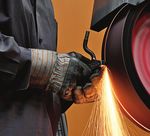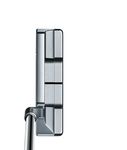ART OF PUTTING & SELECTION GUIDE
←
→
Page content transcription
If your browser does not render page correctly, please read the page content below
A Modern Craftsman Inside the Cameron Putter Studio in Southern California, my team and I are focused on one simple goal, producing the finest putters in the world. Every day, we strive to learn more about how the ball, the putter and the golfer work together, and how we can improve that connection. Using state-of-the-art diagnostic tools, we gather information on how the world’s best players approach putting. With those insights we continually experiment with new designs, materials and technologies. This guide will help you select a putter to improve your performance on the green. The key elements of putter selection are length and toe flow, but all aspects of putter selection – including shape, weight, loft and lie are explained. Whichever Cameron putter you choose, you can count on an unparalleled attention to detail that ensures complete harmony between how it looks, sounds, feels and performs.
Shape
Putters are personal.
Many players pick a shape that complements their stroke. Technical Select putters feature sleek, performance-oriented models with
strokes tend to prefer square shapes and mechanical necks. Players new technology, shapes and configurations.
that want to rid themselves of technical thoughts tend towards
GOLO mallet putters are advanced, multi-material designs with
softer lines and flowing necks.
a lightweight face-sole core milled from aircraft-grade aluminum
All Cameron putters are precision milled so the critical angles of the surrounded by a solid 303 stainless steel frame.
face, sole and shaft ensure each putter sits square. Each head is
Futura X putters deliver high MOI performance through multi-
shaped and softened to flow to the ground and inspire confidence
material construction and advanced perimeter weighting.
at address.Path Putters are not pendulums. Putters do not swing vertically back and through along the target The best players in the world keep the face square to the arcing path line. Because of lie angle, the proper putting stroke moves along and the butt of the putter pointed at the midsection throughout an arcing path: slightly inside of the target line, back to square, then the stroke. Selecting the right putter will help you do the same. to the inside again after impact. The proper length putter correctly sets eye position just inside the target line, and the correct amount of toe flow allows the putter to flow squarely to the proper arcing path throughout the stroke.
Length
Length sets eye position.
The ideal putter length sets your eyes 1-2” inside of the target line to
allow you to execute the proper arcing putting stroke while maintaining
good posture and balance. (See the Path illustration)
If your putter is too long, your set-up posture will be too upright with
your eyes set too far inside the target line. For a right-hand golfer this
results in a path that starts too far inside and putts pushed to the right.
If your putter is too short, your set-up posture will be too hunched over
with your eyes set too far outside the target line. For a right-hand golfer
this results in a path that starts too far outside and putts pulled to the left.
EyeLineMinimum near Minimum medium maximum
Toe flow Toe flow Toe flow Toe flow
Bent and Straight shaft necks provide Plumbing necks provide a medium toe Flare and Flow necks provide maximum
minimum toe flow and can help players flow and are appropriate for players toe flow and can help players with overly
who tend to manipulate the face with with naturally flowing strokes who mechanical putting strokes that lack
their hands. These strokes tend to start prefer a balanced putter design. natural flow. These strokes tend to start
inside the ideal arc, with missed putts outside the ideal arc, with missed putts
generally pulled. typically pushed.
Toe Flow
Everyone needs toe flow.
In order for the putter head to move squarely along the proper If your stroke does not track along the proper arcing path, choose a
arcing path, the toe of the putter must “flow” throughout the stroke putter that helps correct it. If your stroke flows naturally, choose a
(see the Path illustration). How and where the neck or shaft of the putter that flows with it. This will reduce the tendency to manipulate
putter joins the head determines its toe flow. the putter face with your hands. The best way to find the toe flow
that corrects or compliments your stroke is to hit straight, flat putts
from 20ft to see what works best.Weight For most players, the standard Cameron weight configuration will produce the ideal balance and feel to execute the proper stroke. If your stroke tends to decelerate, if your hands get too active, or if you have too much wrist break, you should consider a heavier head or a Dual Balance putter that is heavier overall. Loft & Lie Cameron Putter Studio research shows that a ball pushes down slightly into the grass on a green, and that 3.5° of loft is needed to lift the ball up and on to the surface for a smooth roll. The key to finding the proper lie angle is finding the correct putter length. Standard lie angle works for the vast majority of players if they have the correct length.
You can also read



























































